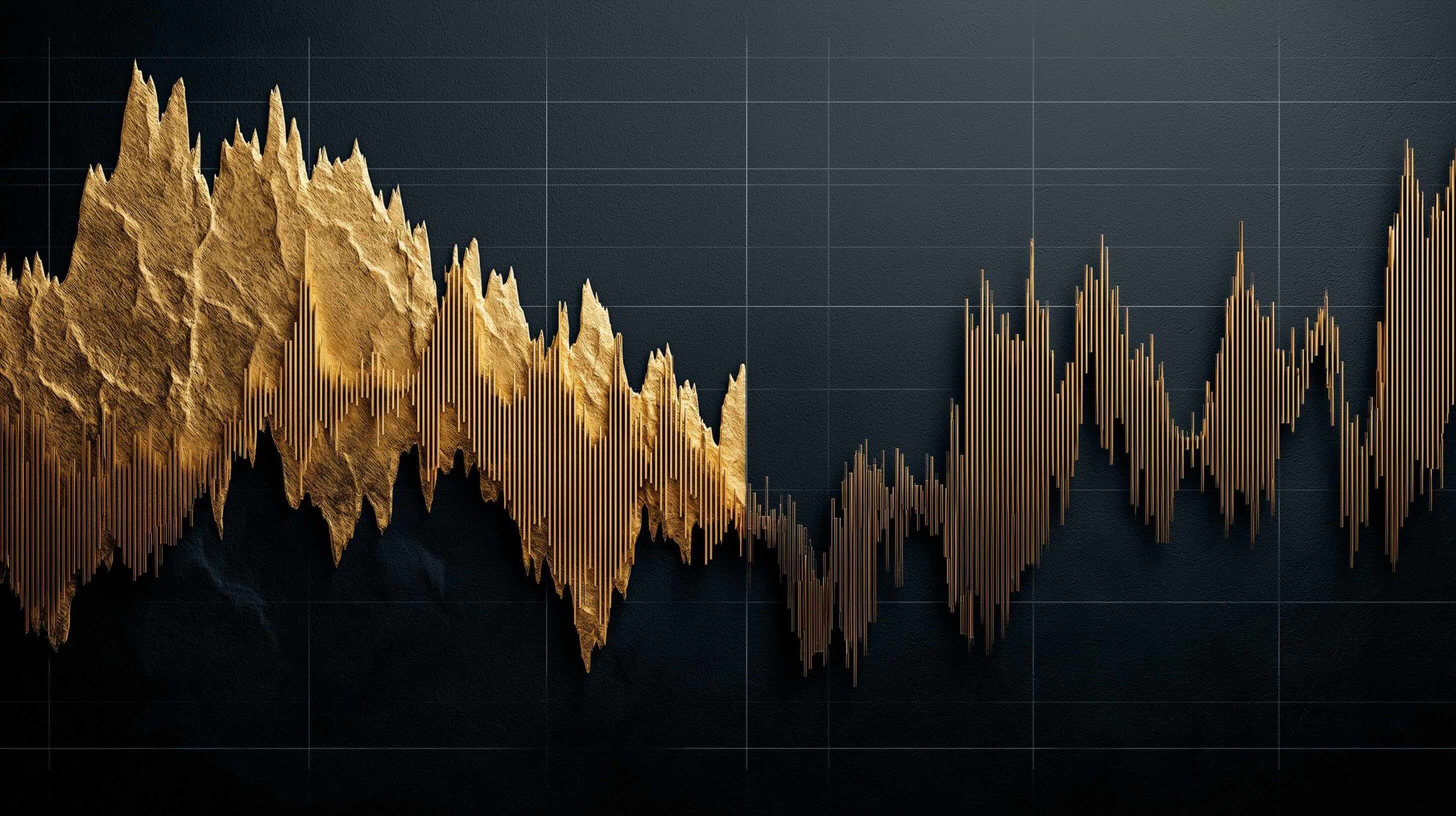- Gold’s record-breaking run: Gold prices smashed through the $4,000/oz barrier for the first time ever in October 2025, reaching an intraday high around $4,059 on Oct. 8 [1]. As of Oct. 10, gold trades near $3,975/oz [2] – up ~52% year-to-date, dramatically outperforming stock indices [3]. This historic surge reflects investors piling into safe-haven assets amid economic and geopolitical jitters.
- Stock indices at all-time highs: The Nasdaq-100 index has exploded to fresh records above 25,000 (closing at ~25,137 on Oct. 8 [4]) on the back of a tech stock frenzy. It’s up roughly 19–20% in 2025 [5]. The NYSE U.S. 100 (top 100 NYSE-listed firms) isn’t far behind – recently near its own peak around 18,150 [6] – reflecting broad strength in large-cap equities. Stocks and gold rallying in tandem is highly unusual, signaling both risk-on optimism and risk-off hedging at once [7].
- Drivers of the boom: A Federal Reserve policy U-turn – shifting from rate hikes to rate cuts in late 2025 – has injected fuel into both markets. Lower interest rates bolstered stocks by reducing borrowing costs and lifting growth prospects, while also weakening the dollar and bond yields, which supports gold [8] [9]. Economic indicators have been mixed (e.g. core inflation ~2.7% [10]), but cooling price pressures and a softening job market have reinforced expectations of further Fed easing [11]. At the same time, geopolitical tensions – including war conflicts and a U.S. fiscal standoff – have spurred a flight to safety. For example, a Middle East conflict in Gaza prompted safe-haven flows into gold (even as a ceasefire was reached by Oct. 10) [12] [13].
- AI frenzy vs. safe-haven demand: 2025 has seen a blockbuster tech rally powered by artificial intelligence euphoria. Massive deals (like an AMD–OpenAI partnership) and surging chip stock prices sent the Nasdaq and S&P 500 to record highs [14]. Nvidia’s stock is up ~41% YTD, Oracle +73%, and Palantir +143%, exemplifying the AI-driven boom [15]. This “gold rush” in tech has vaulted the Nasdaq-100 upward. Simultaneously, gold is shining as “insurance” against market risks – from high global debt to potential inflation – with central banks and investors buying aggressively [16] [17]. One analyst noted the paradox: “The fact that gold and stocks are rallying together is unusual… it speaks to a bifurcated market psychology: optimism on innovation, but hedging against risk.” [18]
- Historic performance snapshots: Over the past year, gold’s ~50%+ jump far outstrips U.S. stock index gains (Nasdaq-100 ~20%, NYSE 100 ~15%) [19] [20]. But in longer horizons, stocks have the edge: the Nasdaq-100 has nearly tripled in the last 5 years and gained ~500% over 10 years (riding tech growth), vastly outperforming gold’s roughly 150% 5-year rise and 250–300% 10-year rise. Broad NYSE stocks delivered steadier growth between these extremes. In short, equities historically generate higher returns, while gold tends to lag in bull markets – except during periods of crisis or inflation, when gold often leaps ahead as a safe store of value.
- Risk & volatility comparison: Gold and stock indices carry very different risk profiles. Nasdaq-100 is heavily tech-focused and volatile – it can soar in boom times (as in 2020–2021 or 2025) but also plunge sharply (e.g. the 2000 dot-com crash or any future correction). NYSE 100 companies (blue-chip industrials, finance, energy, etc.) typically have more moderate swings and often pay dividends, making this index somewhat less volatile than tech-centric indexes. Gold is traditionally less volatile day-to-day than stocks, but it can experience rapid spikes or drops driven by macro events. Unlike stocks, gold doesn’t produce earnings or yield – its value hinges on market sentiment, inflation expectations, and supply/demand. In stable times gold might underperform, but it shines in uncertainty. For example, in market panics or when real interest rates turn negative, gold prices often climb while stocks tank, providing a buffer. Conversely, during strong economic expansions, equities thrive and gold can stagnate or retreat.
- Diversification benefits: For investors, combining gold with stocks can enhance diversification. Gold’s correlation with stocks is typically low or even negative during stress periods [21]. In 2025 we saw an odd phase of both rising together, but generally, gold has acted as a hedge: in recessions or crashes (when stock indices dive), gold often holds its value or rises. A portfolio holding both can thus “maintain stability, even during volatile times”, as one analysis notes [22]. NYSE 100 and Nasdaq 100 themselves offer diversification across companies, but both are equity assets affected by economic cycles. Gold, as a commodity, offers true diversification because its drivers (inflation, currency, fear) differ from corporate earnings. Financial advisors often recommend a modest gold allocation (e.g. 5–10%) alongside stocks to reduce overall risk. 2025 has illustrated this: even with stocks at records, gold provided insurance against looming threats, which paid off with outsized gains.
- Recent news & market trends: Several key trends underpin the 2025 moves: Monetary policy is turning accommodative – the Fed made its first rate cut in September and is expected to cut again in late October (futures put ~95% odds on another 0.25% cut) [23]. This pivot has pushed the 10-year Treasury yield down to ~4.1% [24], boosting equity valuations and diminishing the appeal of cash, thereby driving money into both stocks and gold. Economic signals are mixed: inflation is off its peak and near target range [25], and a mild slowdown in hiring and spending is evident, which paradoxically cheered markets (soft data increases the likelihood of Fed easing) [26] [27]. At the same time, a brief U.S. government shutdown in October and a heated budget standoff in Washington barely dented investor confidence [28]. Traders largely shrugged off the fiscal drama “like a rerun” knowing such impasses have historically resolved without lasting damage [29]. Globally, a “shifting geopolitical landscape” has kept risk hedges in play [30] – from the conflict in the Middle East to tensions in Europe and ongoing trade wars. Notably, President Trump’s new tariffs on various imports (announced to take effect Oct. 1) caused only ripples in U.S. stocks [31] but added to the narrative of uncertainty supporting gold [32]. In commodity markets, oil prices have been relatively subdued around $60s per barrel, so inflation fears stem more from wage and fiscal dynamics than energy. Overall, 2025’s market climate is a unique mix: strong optimism around innovation and growth, alongside undercurrents of caution about politics and global stability.
- Gold vs. stock indices for investors (explained):Gold is a physical commodity and longstanding store of value – essentially a currency alternative that central banks and investors hold as a hedge. It doesn’t pay dividends or earnings; its appeal is that it tends to preserve purchasing power over time and often rises when paper assets falter. Stock indices like the NYSE 100 and Nasdaq-100 represent ownership in companies – they are collections of stocks (equities) that earn profits, pay dividends, and grow with the economy. The Nasdaq-100 covers 100 of the largest non-financial companies on the Nasdaq exchange (dominated by technology giants), whereas the NYSE 100 tracks 100 top companies on the New York Stock Exchange (spanning various sectors like finance, healthcare, industrials, consumer goods, as well as some tech). Stocks historically offer higher long-term returns because companies can increase their earnings over time, but they are susceptible to market crashes, earnings disappointments, and economic downturns. Gold, by contrast, often holds its value when inflation erodes the dollar’s buying power or when crises make investors run from stocks to safety. For a beginner, the key difference is growth vs. safety: stock indices are growth-oriented assets (with higher risk/reward), while gold is more of a defensive asset (lower long-run return but good for capital preservation during turmoil).
- Expert insights – bulls vs. bears: The concurrent surge in gold and stocks has left experts debating what comes next. Caution flags are flying for some: The International Monetary Fund warned that lofty equity valuations could face a sharp correction [33]. JPMorgan’s CEO Jamie Dimon similarly cautioned there is a “heightened risk of a significant correction in the U.S. stock market within the next 6 to 24 months” [34]. The Bank of England, in its October financial stability report, noted that stock “valuations appear stretched, particularly for technology companies focused on AI,” and warned of a potential “sudden correction” if overly optimistic assumptions falter [35]. In other words, some see echoes of a bubble, comparing the AI-driven enthusiasm to late-1990s dotcom exuberance. One portfolio manager observed that the market’s love affair with AI stocks is a “wave” that “will eventually crest and decline” – suggesting the tech rally won’t go on unabated forever [36]. On the flip side, optimists argue that this time the rally rests on solid fundamentals, not just hype. Analysts at Goldman Sachs point out that unlike the pure speculation of the dotcom era, today’s tech boom is underpinned by real earnings growth and transformational AI technology, with incumbent giants (the “Magnificent Seven”) driving profits [37]. “We’re not seeing signs of complacency… this is the least loved bull market on record,” noted one chief strategist, implying many investors are still cautious – which could actually prolong the rally as there’s “cash on the sidelines” to push stocks higher [38]. Jeremy Siegel, a veteran economist, argues that cooling inflation alongside a not-too-hot economy is “a recipe for the Fed to continue easing,” and that stocks can “weather slower growth” as long as price pressures stay tame [39]. In the gold camp, analysts at ANZ Bank remain bullish, citing “slowing economic growth, higher inflation, a shifting geopolitical landscape and diversification away from the U.S. dollar” as factors that will keep demand for gold strong – and noting that central banks continue to be major gold buyers [40]. This suggests the support for gold could be structural, not just a short-term blip.
- Forecasts – what’s next for gold, NYSE 100, and Nasdaq 100: In the short term, many foresee potential turbulence. After such a steep ascent, gold may enter a consolidation phase. Options markets show a rise in volatility and more traders buying downside protection for gold, hinting at near-term caution [41]. “It seems as good a time as any for gold bulls to book some profits. Still, any pullback could be limited,” says Matt Simpson, senior analyst at City Index [42] – implying that while gold might dip from its peak, deep corrections are not expected unless the macro backdrop radically improves. For stocks, the next few months could bring heightened volatility as well. The Nasdaq-100’s relentless climb has some investors on edge for a correction, especially if earnings from the big-tech leaders or economic data disappoint. Seasonal trends and profit-taking could induce minor pullbacks. However, barring any shock, the overall trend remains cautiously positive. The Fed’s continued rate reductions (another quarter-point cut is highly anticipated in the Fed’s late-October meeting [43]) provide a tailwind. Lower yields and easier financial conditions should keep supporting equity valuations and could prevent a major stock downturn in the immediate term. Looking further ahead, the consensus is split. For the long-term investor (5–10+ year horizon), equities are expected to outperform gold as they traditionally do – companies will innovate, earnings will compound, and stock indices should rise accordingly (albeit with bumps along the way). The Nasdaq-100 in particular could continue to lead if AI and tech revolutionize industries, though probably not at the breakneck 50%+ annual clip seen in extreme years. Some forecasters see the Nasdaq and NYSE 100 continuing to hit new highs into 2026 if interest rates stay low and growth holds up, with Goldman Sachs even upping its S&P 500 year-end 2025 target to ~6,800 (implying more upside) [44]. For gold’s long-term outlook, many analysts remain constructive given the backdrop of elevated global debt and periodic inflationary risks. J.P. Morgan Research has projected further gold upside through 2025 and 2026, especially if real interest rates turn negative and central banks keep buying [45]. It’s not out of the question that gold could climb toward $4,500 or $5,000 in a few years if the right mix of inflation and uncertainty persists, according to some bullish scenarios. That said, if the economy enters a robust, low-inflation expansion, gold could also languish or pull back as investors rotate into riskier assets. In essence, gold’s future performance will inversely track confidence in the economy – strong growth and stability might cap gold, whereas any resurgence of inflation or crises would send it higher.
- Bottom line – finding balance: 2025 has delivered an extraordinary episode with both gold and major stock indices achieving record highs simultaneously. Public investors should recognize that this is a rarity; in most periods, these asset classes behave very differently. For those new to investing, the takeaway is that gold and stocks serve different purposes. Gold is a classic “fear asset” – it tends to do best when others are fearful (recession, war, inflation), acting as a form of insurance. Stock indices like the NYSE 100 and Nasdaq-100 are “greed assets” – they do best when confidence and growth are abundant, rewarding investors for taking on risk. Rather than asking which is better outright, savvy investors often hold both: stocks for growth potential and gold for protection. In fact, the year’s events highlight the wisdom of diversification. An investor who held a mix of gold and equities likely saw robust gains with lower volatility – enjoying the stock rally fueled by AI optimism, while also benefiting from gold’s hedge as uncertainties loomed. Going forward, maintaining such a balanced approach could be prudent. If tech stocks continue to roar ahead, your stock index holdings will ride that wave. If a shock hits the market, your gold can cushion the blow. As one market strategist put it, 2025’s dual rally speaks to a market psyche balancing “greed and fear” – embracing innovation-driven returns, yet hedging against tail risks [46]. For the general public investor, the key is to understand these assets’ roles: use stock indices (like Nasdaq-100 and NYSE 100) as engines of wealth creation in your portfolio, and use gold as a stabilizer that can preserve wealth when storms hit. With the economy at an inflection point – and experts divided on what’s next – this balanced strategy can help navigate whatever 2026 and beyond have in store.
Sources: Financial markets data and expert commentary from Tech Space 2.0 (ts2.tech) [47] [48], Reuters [49] [50], Investopedia [51] [52], and other financial media. These include analysis of 2025’s gold and stock performance, Federal Reserve policy updates, and quotes from economists and strategists (e.g. Jeremy Siegel, Jamie Dimon, Goldman Sachs) to provide a well-rounded comparison of gold, NYSE 100, and Nasdaq 100 as investment assets. All statistics are as of October 10, 2025, with historical comparisons across 1-year, 5-year, and 10-year periods for context. [53] [54]
References
1. www.reuters.com, 2. www.reuters.com, 3. www.reuters.com, 4. www.marketpulse.com, 5. www.reuters.com, 6. markets.businessinsider.com, 7. ts2.tech, 8. www.reuters.com, 9. www.reuters.com, 10. ts2.tech, 11. www.reuters.com, 12. www.reuters.com, 13. www.reuters.com, 14. ts2.tech, 15. ts2.tech, 16. ts2.tech, 17. www.reuters.com, 18. ts2.tech, 19. www.reuters.com, 20. www.reuters.com, 21. www.gold.org, 22. www.criticalhit.net, 23. www.reuters.com, 24. ts2.tech, 25. ts2.tech, 26. ts2.tech, 27. ts2.tech, 28. ts2.tech, 29. ts2.tech, 30. www.reuters.com, 31. ts2.tech, 32. www.reuters.com, 33. www.reuters.com, 34. www.reuters.com, 35. ts2.tech, 36. ts2.tech, 37. www.reuters.com, 38. www.reuters.com, 39. ts2.tech, 40. www.reuters.com, 41. www.reuters.com, 42. www.reuters.com, 43. www.reuters.com, 44. ts2.tech, 45. www.jpmorgan.com, 46. ts2.tech, 47. ts2.tech, 48. ts2.tech, 49. www.reuters.com, 50. www.reuters.com, 51. www.investopedia.com, 52. www.investopedia.com, 53. www.reuters.com, 54. www.reuters.com







